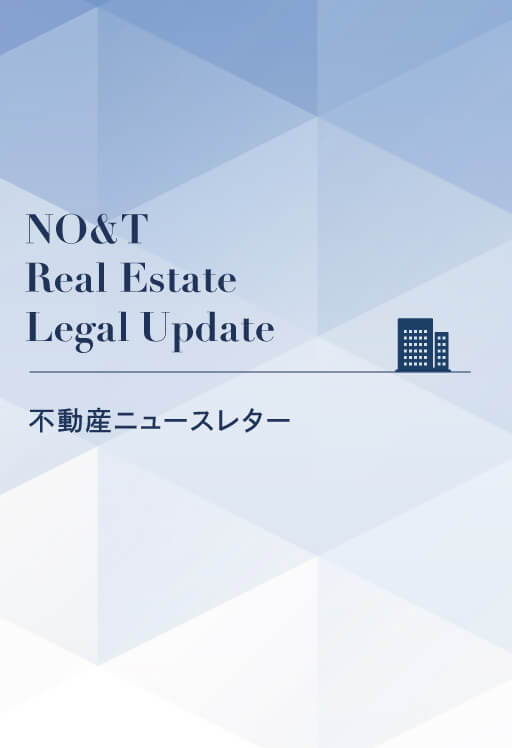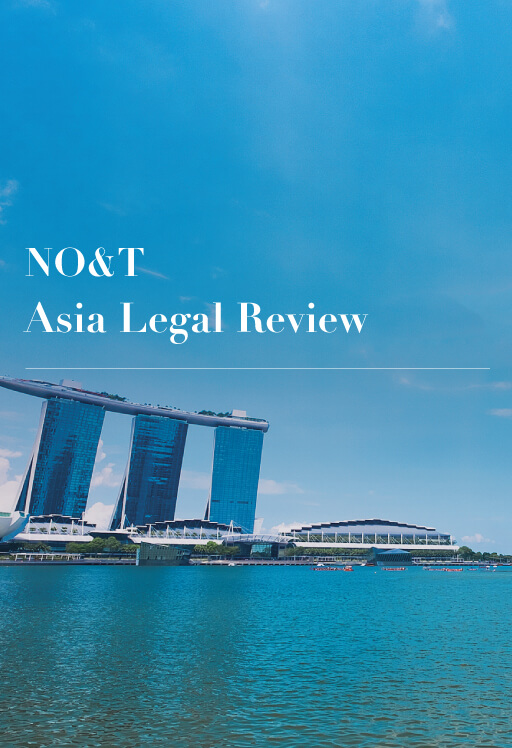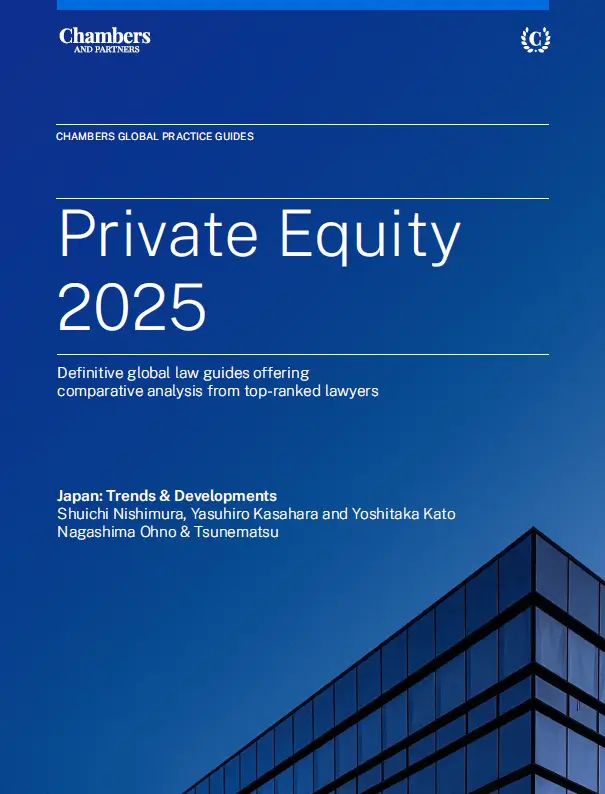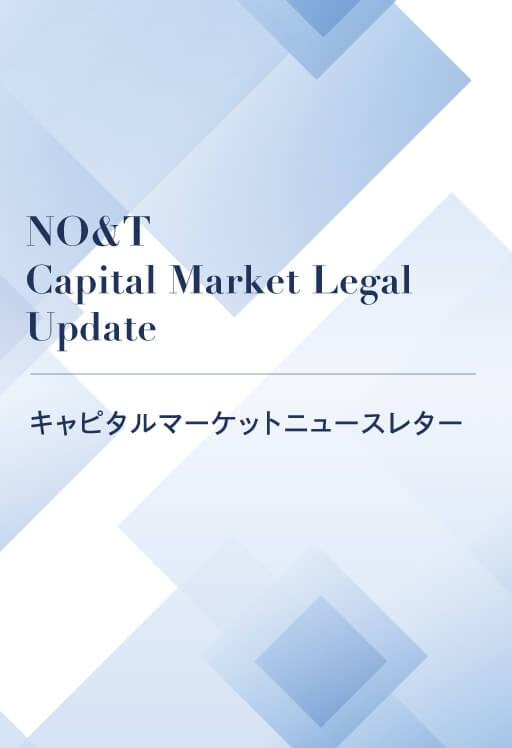
NO&T Real Estate Legal Update
NO&T Capital Market Legal Update
In Japan, while the number of listed REITs (J-REITs) has stagnated since 2020, private REITs have experienced a dramatic market expansion. From March 2020 to March 2025, the number of private REITs has surged from 35 to 60; total assets have increased from ¥3.695 trillion to ¥7.189 trillion; and the number of properties has increased from 918 to 1,981.※1 As a result of successive new market entries, however, many private REITs are relatively small in scale, and there is potential for increased consolidation activity among private REITs going forward, particularly under the influence of rising interest rates.※2
Numerous precedents already exist with respect to listed REIT mergers, including relatively recent examples such as the merger of MORI TRUST Sogo Reit, Inc. and MORI TRUST Hotel Reit, Inc. (March 2023), the merger of Kenedix Office Investment Corporation, Kenedix Residential Next Investment Corporation, and Kenedix Retail REIT Corporation (November 2023), and the merger of Mitsui Fudosan Logistics Park Inc. and Advance Logistics Investment Corporation (November 2024).
On the other hand, there are no precedents for mergers involving private REITs as parties. Although the merger process for private REITs is generally the same as that of listed REITs, differences in their fund features and investor types create unique issues for private REITs. This newsletter provides an overview of the merger process, taking into account the differences between listed and private REITs, and explains several key points that require careful consideration in private REIT mergers.※3
The following table lists the major items related to investment corporation merger procedures and notes issues and considerations relevant to private REIT mergers (noting that this is not exhaustive and covers only selected issues).※4
| No. | Item | Issues and Considerations |
|---|---|---|
| 1. | Execution of confidentiality agreements and selection of advisors | |
| 2. | Conducting due diligence | |
| 3. | Conducting valuations and negotiating merger ratios | See “Calculation of Merger Ratios” below. |
| 4. | Coordination with lenders and other stakeholders | In the case of open-end structures, investment corporation bonds cannot be issued, so coordination with bondholders is unnecessary. |
| 5. | Consultation with competent authorities | Since private REIT mergers are unprecedented, more detailed prior consultation is required compared to listed REIT merger cases. |
| 6. | Sounding out major unitholders (item specific to private REITs) | See “Sounding Out Major Unitholders and Acquisition of Units” below. |
| 7. | Board approval and execution of merger agreement | For private REITs, timely disclosure and extraordinary report filings are unnecessary. |
| 8. | Convening unitholder meetings and setting record date announcements | |
| 9. | Merger announcements and preparing pre-disclosure documents | |
| 10. | Mailing of unitholder meeting convocation notices | |
| 11. | Unitholder meeting |
Special resolution (requires more than 2/3 approval) If simplified merger requirements are met, the surviving corporation does not require unitholder meeting resolution for merger approval. Deemed consent provisions apply unless there is any conflicting proposal or the bylaws exclude deemed consent. |
| 12. | Merger taking effect | See “Treatment of Fractional Units” and “Sponsor Acquisition of Certain Properties” below. |
| 13. | Preparing post-merger documents | |
| 14. | Registration of merger |
In listed REIT mergers, a common valuation approach is valuation analysis methods based on unit prices formed in the J-REIT market, and merger ratios are calculated based on such results. However, since such unit prices do not exist for private REITs, merger ratios would typically be calculated based on net asset value (based on appraisal values).
In connection with this point, in investment corporation mergers, when the consideration paid (total amount of surviving corporation units delivered to merged corporation unitholders) is lower than the merged corporation’s net asset value, the difference is recorded as “negative goodwill.” In the case of private REIT mergers, since valuations are conducted on a net asset value basis, “negative goodwill” would likely remain at a substantially lower amount compared to listed REIT cases. In any event, since mergers involving private REITs are unprecedented, detailed confirmation of accounting treatment from accounting counsel is necessary.
Unlike listed REITs, private REITs are not subject to insider trading regulations, making it possible to directly explain mergers to major unitholders and conduct vote counting.
Additionally, since tender offer regulations do not apply, if vote counting results indicate that the necessary votes for a special resolution at the unitholder meeting cannot be gathered (or there is risk of being unable to obtain the necessary votes), it is possible to acquire units directly from the unitholders indicating opposition. However, in such cases, careful consideration is required regarding whether it is appropriate to conduct acquisitions at amounts with premiums added to net asset value, given fairness issues with other unitholders.
Since private REITs are structured as so-called open-end investment corporations that allow redemptions under certain conditions, it is necessary to consider in advance not only how to handle statutory unit purchase demands from opposing unitholders, but also how to respond when redemption requests are made during the merger process.
In this regard, investment corporations may suspend unit redemptions for the purpose of conducting merger negotiations and mergers pursuant to Article 146, Paragraph 1 of the Investment Trust and Investment Corporation Act (the “Investment Trust Act”), but such redemption suspension cannot exceed three months (Paragraph 2 of the same Article), and public notice or notification must be provided at least one month before the redemption suspension period. Therefore, when conducting redemption suspensions pursuant to the Investment Trust Act, the related parties should consider how to incorporate such procedures into the merger schedule.
Additionally, because merger ratios are mandatory items to be stipulated in merger agreements, the effect of any redemption requests on merger ratios should also be discussed. If redemptions cannot be avoided through redemption suspension, it may become necessary to secure cash for such redemptions.
When fractional units arise from investment corporation mergers, it is necessary to sell units equivalent to the total number of such fractions at a “fair value” and deliver the sale proceeds to the relevant merged corporation unitholders according to their fractional amounts (Article 149-17, Paragraph 1 of the Investment Trust Act).
In the case of listed REITs, fractional units are sold in the market and the sale proceeds are delivered (Article 199, Item 1 of the Regulation for Enforcement of Investment Trust and Investment Corporation Act), but since private REITs cannot be sold in markets, “sales at fair and reasonable amounts in light of the net asset value of the investment corporation issuing such units” must be conducted (Item 3 of the same Article). Since no precedents exist for this point either, consideration is required regarding how to determine both the “fair and reasonable amount” mentioned above and the identity of the purchaser. For private REITs, fractional units may also be processed through redemptions (Article 88, Paragraph 2 of the Investment Trust Act as applied mutatis mutandis pursuant to Article 149-17, Paragraph 2 of the same Act).
While not limited to private REIT mergers, there may be cases where, due to sponsor intentions or because certain properties do not meet the surviving corporation’s portfolio criteria, sponsor acquisition of certain properties from the merged corporation becomes a condition for the merger.
Such acquisitions constitute transactions with interested parties, requiring compliance with Articles 201-2 and 203, Paragraph 2 of the Investment Trust Act, as well as with conditions determined by certain standards set forth in the asset management company’s internal rules (interested party transaction rules, etc.). Typically, sales at or above the most recent appraisal value are required.※5
*1
The Association for Real Estate Securitization, Private REIT Quarterly No.38 (as of March 2025)
*2
While not a merger, there already exists an example where Ichigo Inc. acquired all investment units of a private REIT (Tosho Tokai REIT Investment Corporation) and all shares of its asset management company (August 2024), and such consolidation activities are expected to accelerate going forward.
*3
While a merger between a listed REIT as a surviving corporation and a private REIT as a merged corporation is legally possible, (a) institutional investors who are private REIT unitholders are often reluctant to hold listed REIT units (in some cases, such institutional investors may be unable to invest in listed REITs due to their investment policies), creating potential issues in obtaining special resolutions at private REIT unitholder meetings; (b) if listed REIT stock prices decline significantly due to J-REIT market changes after merger announcements, while private REIT net asset values remain basically unchanged, obtaining consent at private REIT unitholder meetings would become more difficult; and (c) due to insider trading regulations, pre-announcement contact with unitholders requires careful information management, making vote counting on the private REIT side more difficult. These factors create higher hurdles compared to private REIT-to-private REIT mergers. This newsletter primarily considers private REIT-to-private REIT mergers.
*4
In listed REIT mergers, when absorption-type mergers are selected, if the merged corporation has a high proportion of US unitholders, Form F-4 registration statements under US securities law may be required, and consolidation-type mergers are sometimes selected to avoid such burdens. However, private REITs typically restrict sales and transfers to US investors due to the Volcker Rule, so consolidation-type mergers would not be selected to avoid Form F-4 compliance. Therefore, the following primarily considers absorption-type mergers.
*5
How to handle the sale proceeds received by the merged corporation and the capital gains recorded from such sales would also be a point requiring discussion between related parties. Additionally, depending on the scale and schedule of properties to be acquired, there may be risks of failing to meet tax conduit requirements.
This newsletter is given as general information for reference purposes only and therefore does not constitute our firm’s legal advice. Any opinion stated in this newsletter is a personal view of the author(s) and not our firm’s official view. For any specific matter or legal issue, please do not rely on this newsletter but make sure to consult a legal adviser. We would be delighted to answer your questions, if any.


Masato Kumeuchi, Kodai Ebihara (Co-author)


Hoai Tran


Makoto Saito, Shinichiro Horaguchi, Yoshihisa Watanabe, Ramsay Randall (Co-author)


Makoto Saito, Shinichiro Horaguchi, Yoshihisa Watanabe, Ramsay Randall (Co-author)


Masato Kumeuchi, Kodai Ebihara (Co-author)


Hoai Tran


Makoto Saito, Shinichiro Horaguchi, Yoshihisa Watanabe, Ramsay Randall (Co-author)


Makoto Saito, Shinichiro Horaguchi, Yoshihisa Watanabe, Ramsay Randall (Co-author)


Masato Kumeuchi, Kodai Ebihara (Co-author)


Takashi Itokawa, Takahiro Kitagawa (Co-author)


Kenji Utsumi, Masatsura Kadota, Junji Yamanaka (Co-author)


(December 2024)
Mami Ikebukuro, Kenji Utsumi, Makoto Saito, Shinichiro Horaguchi, Yoshihisa Watanabe (Co-author)


(September 2025)
Yasuhiro Kasahara, Masaki Mizukoshi, Yoshitaka Kato (Co-author)


Yusei Uji


(September 2025)
Shuichi Nishimura, Yasuhiro Kasahara, Yoshitaka Kato (Co-author)


Ichsan Montang, Valencia Wijaya (Co-author)


(September 2025)
Yasuhiro Kasahara, Masaki Mizukoshi, Yoshitaka Kato (Co-author)


Yusei Uji


(September 2025)
Shuichi Nishimura, Yasuhiro Kasahara, Yoshitaka Kato (Co-author)


Ichsan Montang, Valencia Wijaya (Co-author)


Ryuji Oka


Yothin Intaraprasong, Theerada Temiyasathit (Co-author)


Yuichi Miyashita, Miho Susuki (Co-author)


Makoto Saito, Shinichiro Horaguchi, Yoshihisa Watanabe, Ramsay Randall (Co-author)


Yothin Intaraprasong, Theerada Temiyasathit (Co-author)


Yuichi Miyashita, Miho Susuki (Co-author)


Takashi Itokawa, Takahiro Kitagawa (Co-author)


Motoki Saito, Gaku Oshima, Yuta Kawamura (Co-author)